Solo in Cadiz: 2 day guide for a weekend getaway on the Spanish coast
Cadiz is one of those places that has been on my to-visit list in Spain for awhile. The closest I got was catching the sunset in Chipiona, a tiny town a little further north up the coastline, and spending a day in Jerez de la Frontera drinking sherry wine and watching dancing horses. On this trip to Spain, I spent 2 nights in Cadiz and really enjoyed this coastal town that is also one of the oldest cities in Europe that’s still around – it’s a nice break from busy Seville and Cordoba – here’s my guide on travelling solo in Cadiz if you have just one weekend.
- About this 2 day Cadiz guide
- How to get to Cadiz
- Explore Cadiz on foot: Free walking tour
- Day 1
- Plaza San Juan de Dios: Start here
- Teatro Romano: Historical monument
- Parroquia de Santa Cruz: Former cathedral
- Cathedal de Cadiz: Panoramic views
- Campo Del Sur: Walk along the coast
- Calle Virgen de la Palma: Prettiest street
- Playa de La Caleta: City beach
- Castillo Santa Catalina: Views
- Castillo San Sebastian: Sunset & seaview
- Day 2
- Where to eat in Cadiz
- Where to stay in Cadiz: Dormir en Cadiz
About this 2 day Cadiz guide
Cadiz is practically its own little island off the southwest coast of Spain – it’s connected to the mainland by bridges. Cadiz is split into the historic old town and a newer, more modern side – this guide will focus on the old town area because that’s where most of the sights are, though the larger beaches are on the new side.
Also, Cadiz old town is not a very big area at all – you can easily walk along the entire perimeter of the old town (roughly 5 km) in an hour or so, so if you had very limited time you can pack a lot of this itinerary into a single day, but I think 2 days / 1 weekend gives you a bit more time to relax.
Big props to Ana from my guesthouse Dormir en Cadiz who was an absolute gem in telling me all the must-see things in Cadiz, and especially in recommending the good food – check out their review below. I’ve compiled those suggestions and my own experiences in this handy Wanderlog map here.
How to get to Cadiz
Train: I took a direct Renfe train from Seville Santa Justa to Cadiz, the journey took about 1hr 45 mins and cost me 16.65 Euros. There are many trains from Seville to Cadiz everyday, and if you book early enough, prices can drop to as low as 7-8 Euros! You could also stop at Jerez de la Frontera along the way.
Bus: You can take the bus from Seville’s Prado de San Sebastian bus station to Cadiz, though it takes about the same time and cost as the train does. Unless you’re much closer to the bus station in Seville, I’d opt for the train so you don’t have to worry about potential traffic jams.
Car: Driving is the fastest way to get from Seville to Cadiz and typically takes about 70 minutes or so.

The bus and train station of Cadiz is located right between the old area and the new area. It took about 20 minutes walk from the train station to get to my guesthouse which was located in La Viña, near La Caleta Beach on the western end of the old town.
Explore Cadiz on foot: Free walking tour
I find that the best way to get your bearings quickly in any city is to do a free city walking tour, and Cadiz is no exception. My guesthouse recommended checking our Cadizfornia or Civitatis for the English walking tours, but because of my schedule to visit the Cathedral in the morning, I ended up going with Pancho Tours in the afternoon instead and overall had a very good experience and would recommend them. They also offer Spanish tours in Cadiz.

Typically these tour groups meet at Plaza San Juan de Dios at either 1030am (morning) or 1pm (afternoon), usually in front of the Ayuntamiento or City Hall building, and end at La Caleta Beach on the western end of the peninsula in about 2 hours. What I suggest is doing the walking tour first to learn the history of these places, and then doubling back later if you want to spend more time exploring them further.
While these walking tours are free, you usually tip the guide at the end of the tour however much you want to pay. My group had 8 people including myself, and my Pancho Tour Guide was quite excellent, full of interesting information and stuff about the city you might not know from just looking around, so definitely worth the tip.
But if you rather explore Cadiz on your own time without taking any tours, I’ve mapped out the must-sees in Cadiz here for you.
Day 1
Plaza San Juan de Dios: Start here
Plaza San Juan de Dios is a logical starting point for most tours around Cadiz as it is close to the train station, bus station and the nearby port where cruises stopover. The palm trees give this plaza a nice atmosphere against the backdrop of the Ayuntamiento or City Hall building.
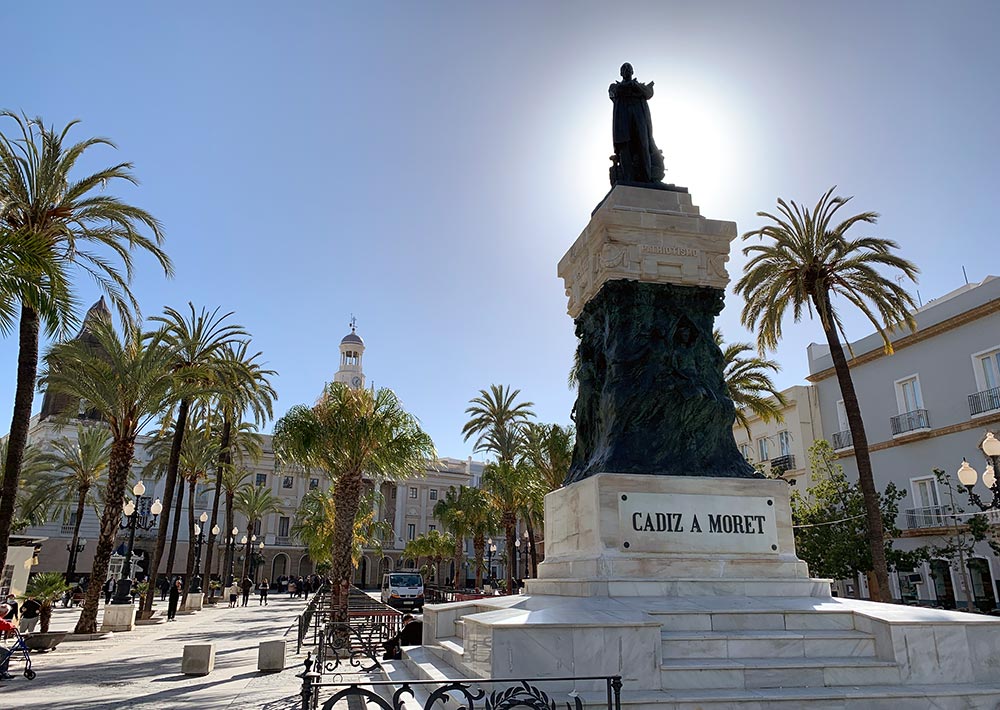
Teatro Romano: Historical monument
The Roman Theatre in Cadiz was found fairly recently in 1980 when a fire uncovered the ruins in the El Populo district, and it turned out to be one of the largest and oldest roman theatres ever found. The museum is free to enter and the walking tours usually pass through as well though they don’t spend a lot of time in the indoor museum bit where you can see scale models, dioramas and information about the history of the theatre and what they uncovered.
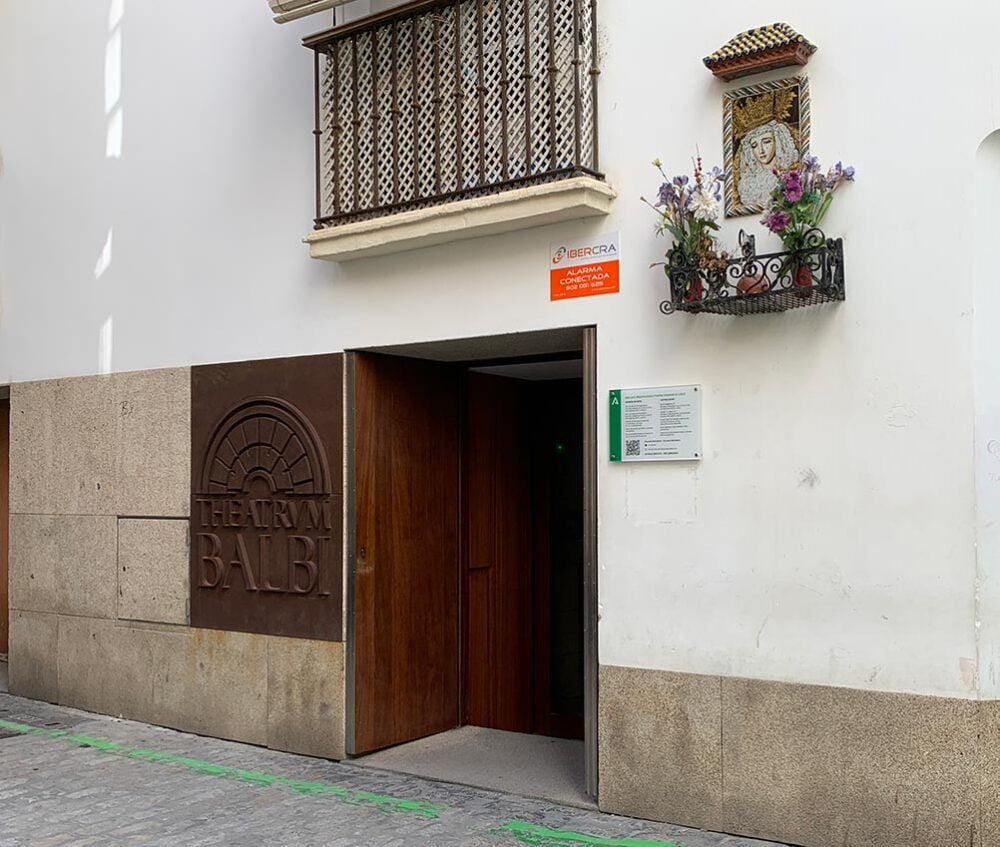
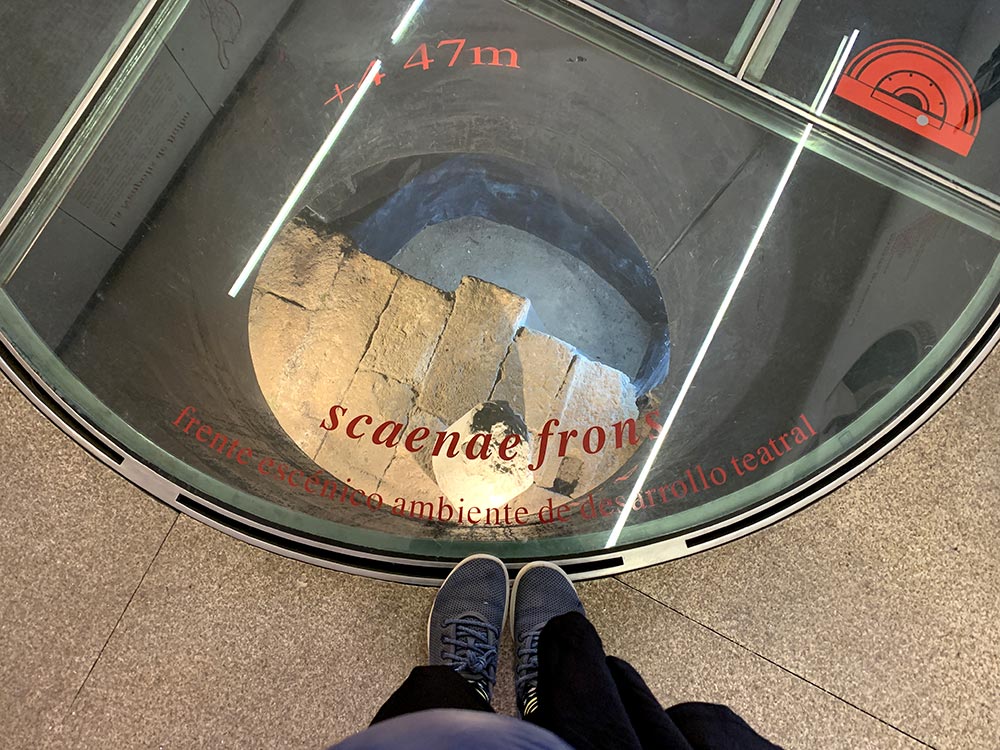
The museum is one-way, so the highlight is at the back where you walk through the tunnels and see the excavated remains of the theatre itself – it was built to seat around 10,000 people. I think it’s cool how they’ve left the surrounding buildings there so get the sense of how all these civilisations were piled on top of each other.


Visiting info: Free to enter, open in morning only on Sundays and closed on Mondays. Check entry hours here.
Parroquia de Santa Cruz: Former cathedral
The Church of Santa Cruz is a small church in El Populo that doesn’t look particularly significant, especially compared to the more majestic Cathedral right next door, but this was the old cathedral of Cadiz back in the day and the oldest church in Cadiz dating back to the 13th century. Built in a former mosque, you can see that gothic Mudejar style that’s present in a lot of Andalusian architecture, as well as a surprising number of silver treasures.
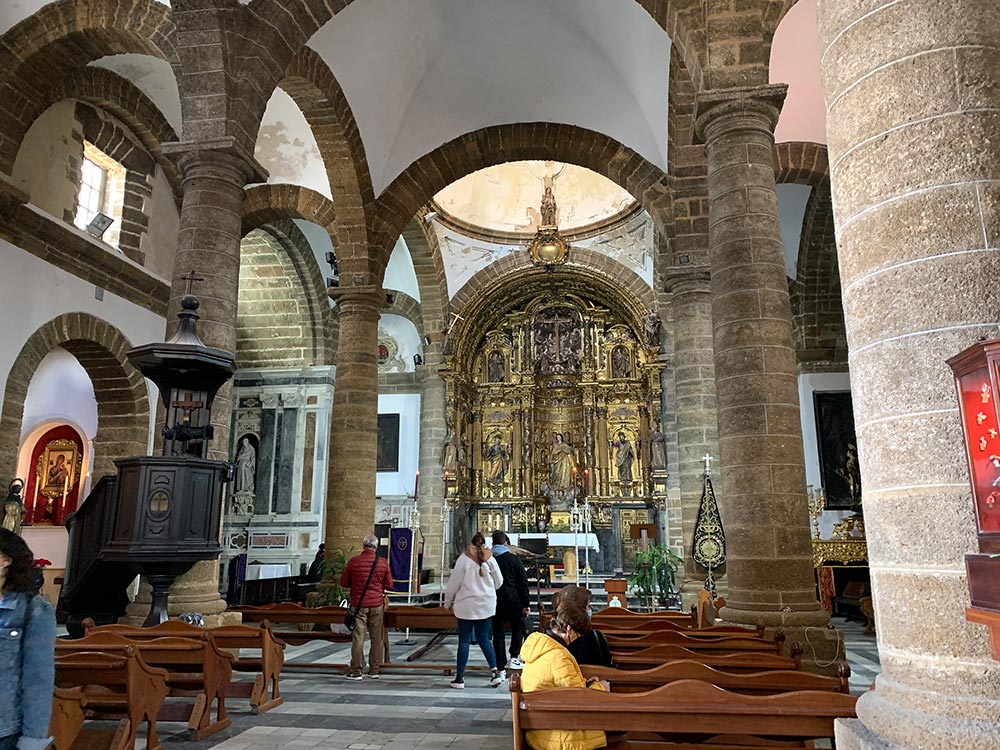

I happened to be in Cadiz a week or so before Semana Santa activities, so saw lots of stands going up around the actual cathedral in preparation for Easter week, and also this procession where they marched the wooden cross around the streets of Cadiz.
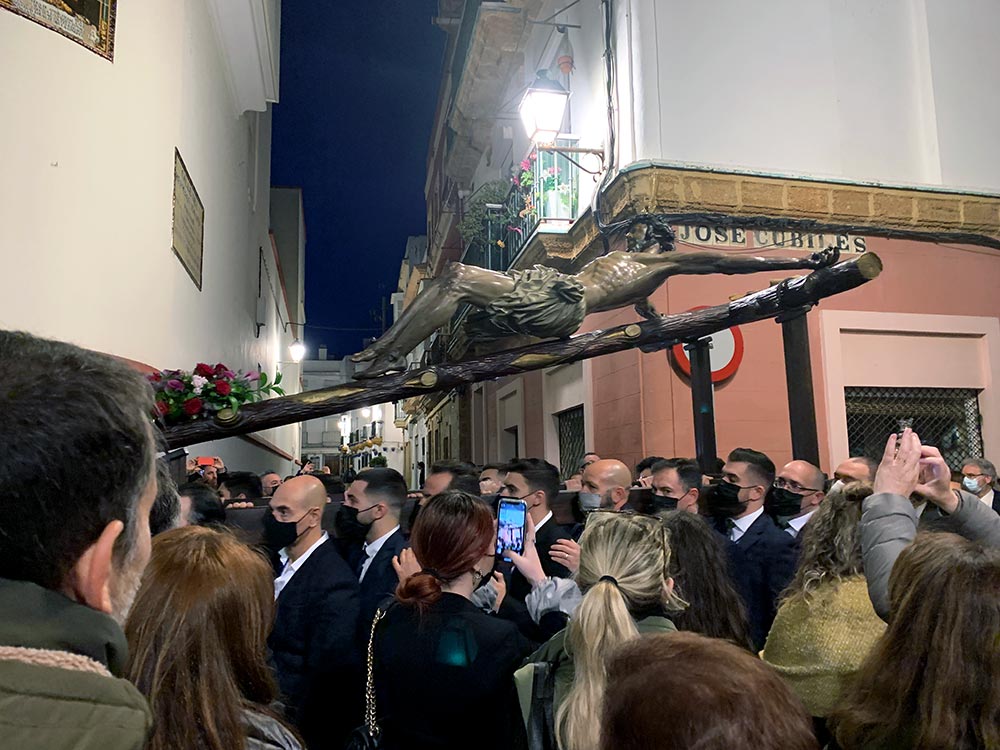
Visiting info: Church is free to enter, with visiting times generally in the morning and for an hour in the evening. Check out the Cadiz Tourism page for more info.
Cathedal de Cadiz: Panoramic views
One of the centrepieces of any old town in Europe is the cathedral, and Cadiz’s Cathedral is no exception. Sometimes called the new cathedral to differentiate it from the old cathedral (Santa Cruz church), this 16th century church is quite distinctly bisected in two because it took 117 years to build – it started out as a baroque style church (the brown bits) and was finished as a neoclassical style church (the white bits)
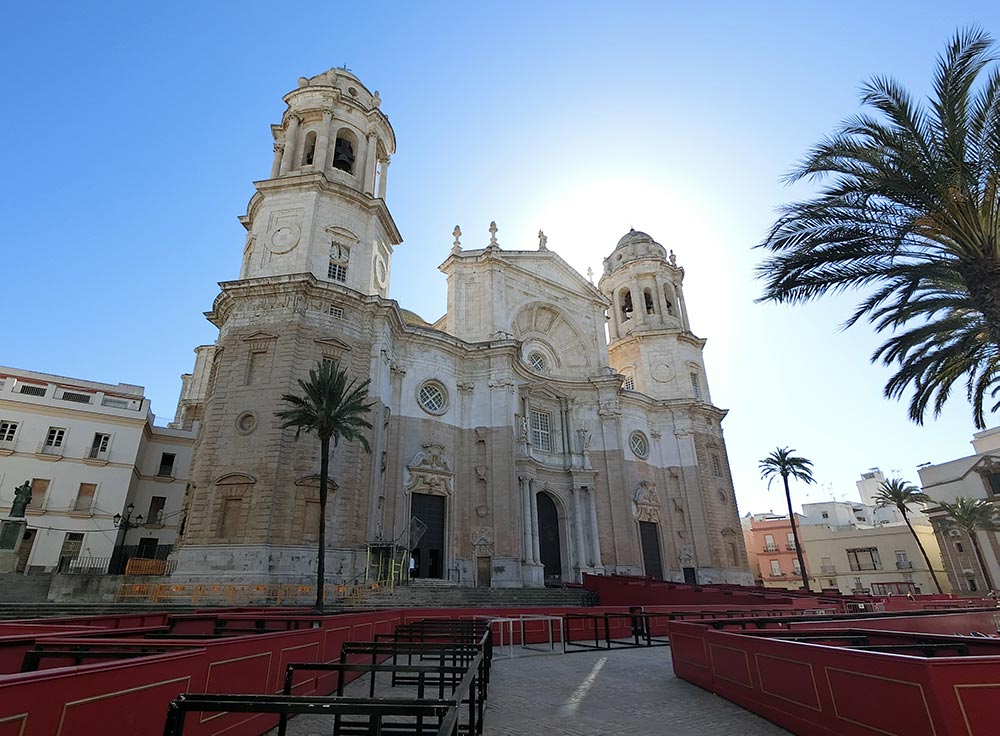


Cadiz Cathedral has 2 towers, and you can climb up a sloping ramp to the top of the Levante Tower to see the view of the city and coastline from up high. It’s pretty windy up there, and also where the church bells are hung so it can get pretty loud every half hour or so when the bells chime!


Visiting info: Cadiz Cathedral is open 10am – 8pm except on Sundays where it opens at 130pm. A general ticket costs 7 Euros and gives you access to the cathedral, tower and Casa de la Contaduria. There is an online audio guide website in different languages that gives you more info about the cathedral. Check opening hours and buy tickets online at the Catedral de Cadiz website.
Campo Del Sur: Walk along the coast
All along the south and west stretch of Cadiz old town is the Campo del Sur, a lovely wide walkway right by the sea wall that protects the city. Another name for this area is Little Havana, because apparently that iconic waterfront in Havana, Cuba was modelled after Campo del Sur – Cadiz was one of the main ports that serviced the trade route between the Americas and Spain.

I strolled up and down the length of Campo del Sur several times just admiring the sea view and waterfront. It connects from La Caleta Beach all the way to the beaches in the new side of Cadiz if you kept walking. If you are feeling up to an intensive walk, you could actually circle the entire coastline of the old town area in about an hour or so of continuous walking, but I’ve broken it up for this itinerary.
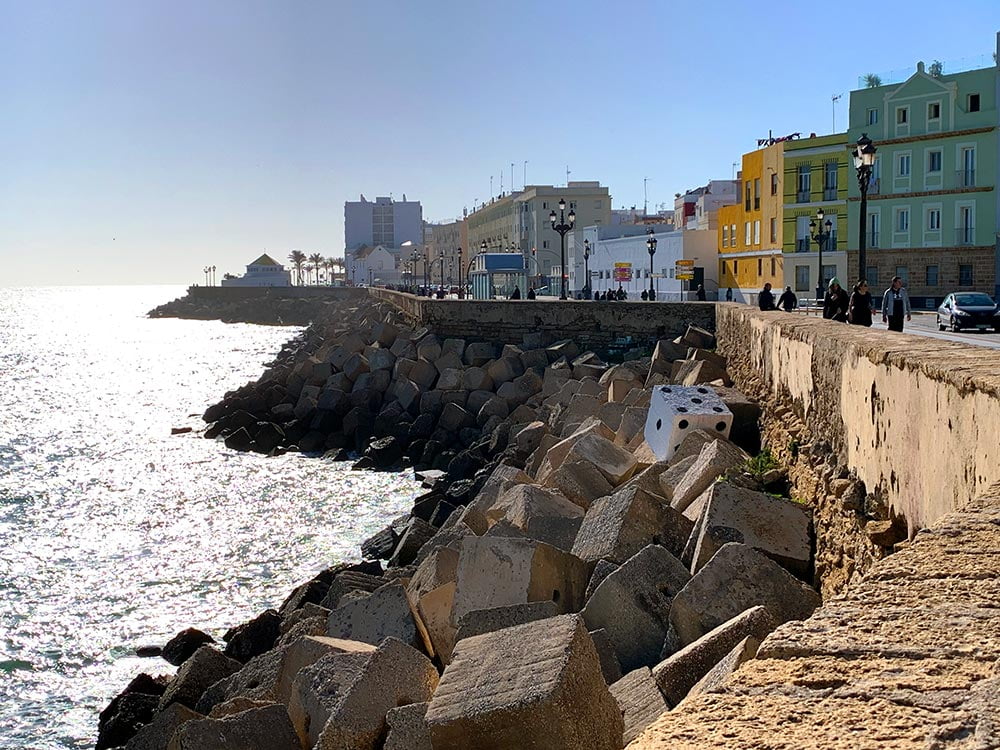
Calle Virgen de la Palma: Prettiest street
Located in the neighbourhood of La Viña which was once the stronghold of the city’s fishermen, Calle Virgen de la Palma is a nice pedestrian stretch near La Caleta Beach lined with palm trees. My guesthouse was just off this street so I spent a lot of time around here. The palm trees give it a nice tropical feel even in the crispy spring weather when I was there, and in the afternoons and evenings, the restaurants would put tables outside for some al fresco dining.
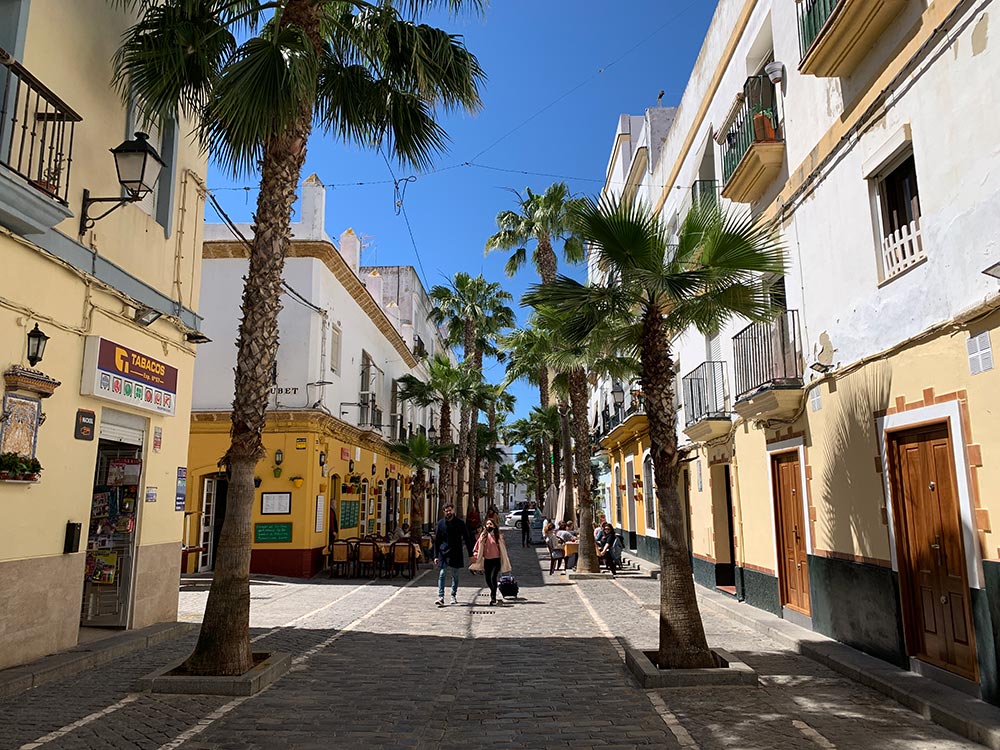
The western end of the street leads you to La Caleta Beach, and the eastern end brings you to the doorstep of the Church of Our Lady of the Palms (Iglesia Nuestra Señora de la Palma), a small church named for a lady who apparently kept the flood waters at bay during a devastating tsunami around here in 1755.
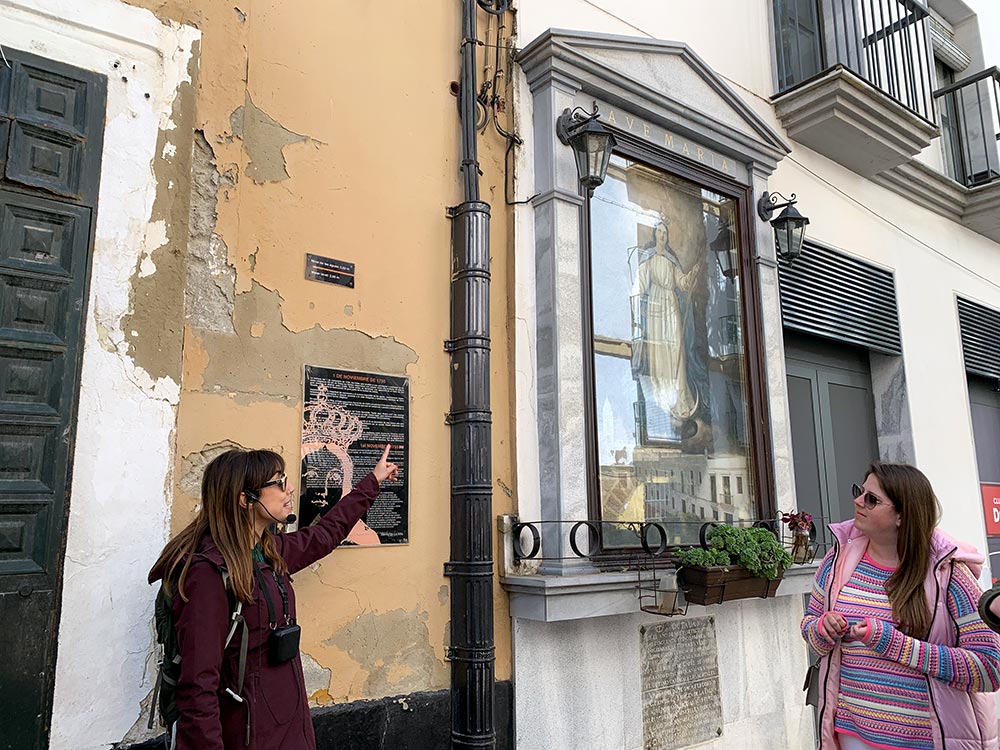
Playa de La Caleta: City beach
Cadiz’s main beaches these days are located on the new side of the city, and La Caleta is the only city beach found in the old town area. In summer, this beach is crowded with sunbathers but since I was there in spring, there were just 1 or 2 oddballs who took the brave plunge in the cold ocean. Most others just enjoyed sitting around on the sand and enjoying the sea breeze, and there were lots of dogs playing on the sand.

If you have a niggling feeling that you’ve seen La Caleta Beach somewhere before, it was actually where they filmed that scene of Halle Berry emerging from the sea in an orange bikini from the 2002 James Bond movie Die Another Day! Keep watching that clip and you’ll even spot Santa Catalina Castle (more about that below!) in the background.

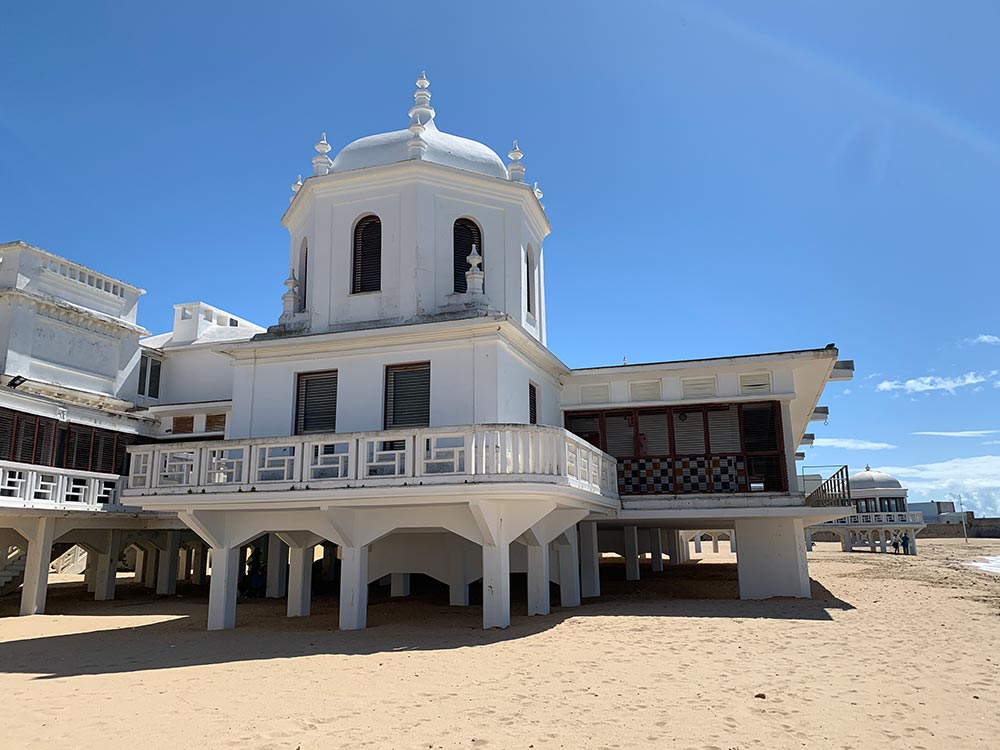
Castillo Santa Catalina: Views
There are two castles in Cadiz that flank La Caleta Beach, and Santa Catalina Castle is the only one you can enter and explore. What makes this castle interesting is that it’s built in a star shape though it’s hard to tell from ground level. Inside the castle grounds is a church, and they sometimes hold exhibitions in here. You can walk along the castle walls to admire the sea view, but honestly there’s not that much else.
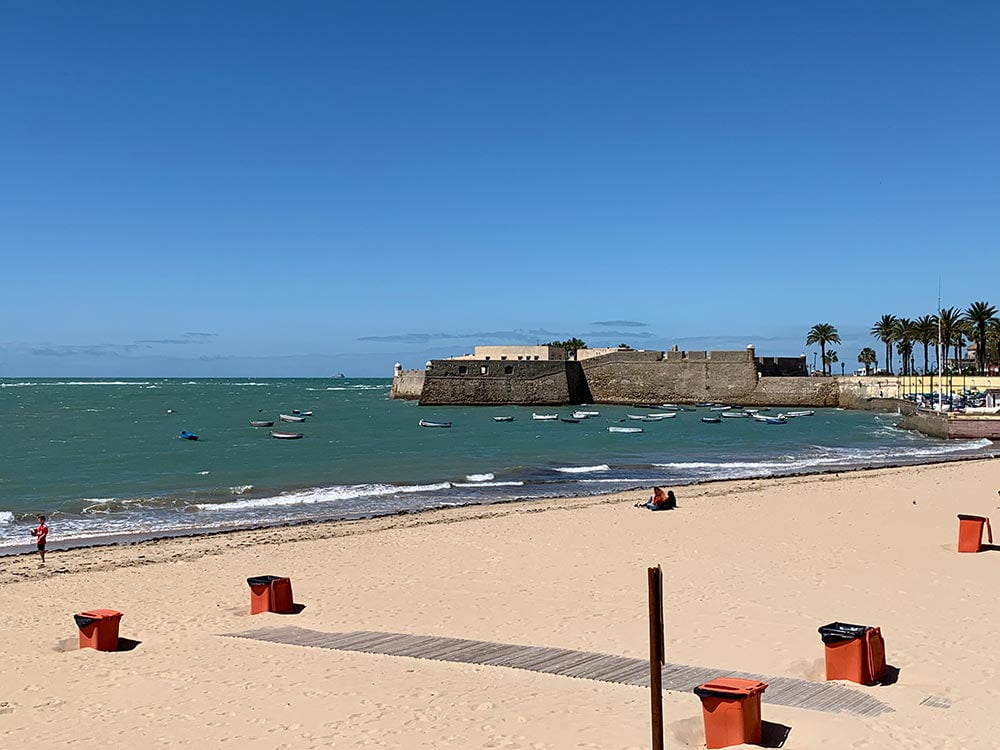


Visiting info: Santa Catalina Castle is free to enter. Open Monday to Friday 11am – 8pm.
Castillo San Sebastian: Sunset & seaview
Double back to the southern end of La Caleta Beach and look for the white arch that will lead you to the bridge that joins San Sebastian Castle to the mainland of Cadiz. This bridge is particularly popular for sunset as it extends out to sea westwards, and when the tide is low, patches of beach are revealed on either side of the pathway.
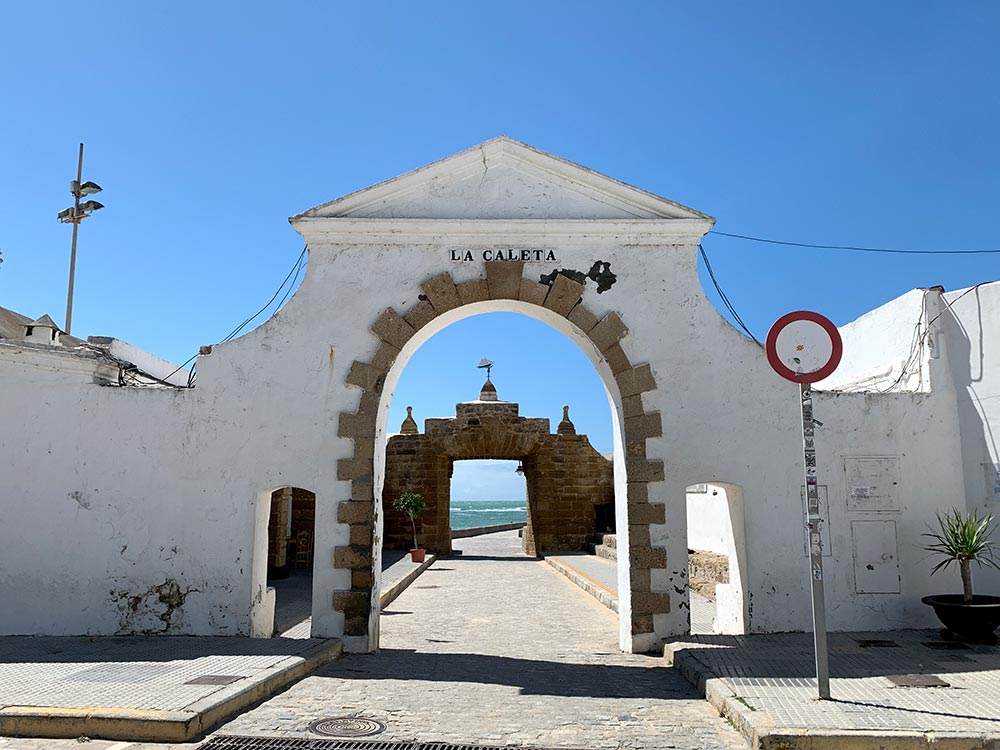
You can walk out to San Sebastian Castle, but no entry is allowed onto the grounds. You do get a nice coastal view of La Caleta Beach though. Note that if you go out on the bridge during high tide, do be careful of getting sprayed by inopportune waves

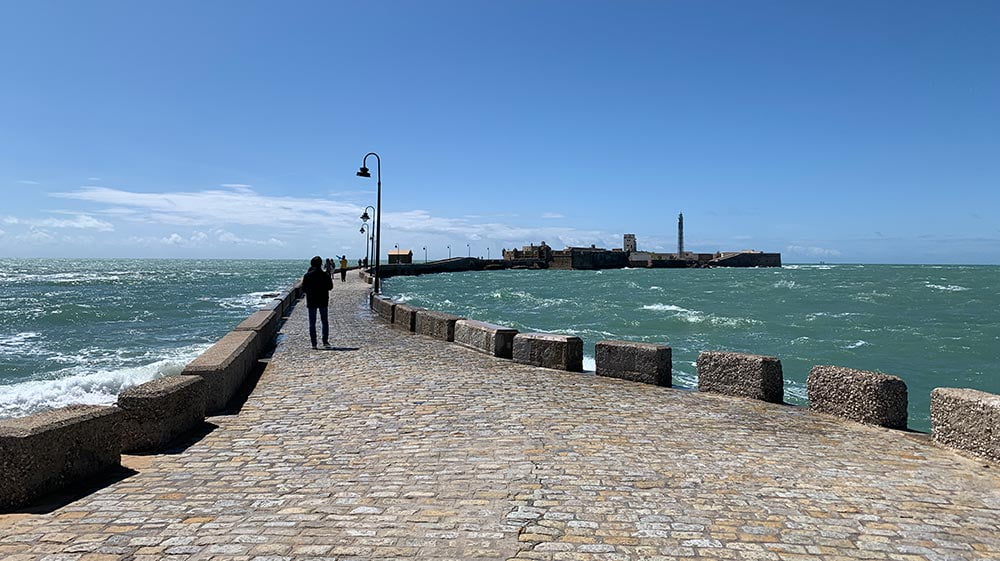

Day 2
Centro Mercado Cadiz & Plaza de las Flores
Start your 2nd day in Cadiz at the bustling Cadiz Central Market, one of the oldest covered markets in Spain dating back to the 1800s. You can see all the live seafood and other produce on sale in this neoclassical style building, with its columns inside. Fresh food aside, the back of the market is also the spot to check out local tapas during the day and evening.

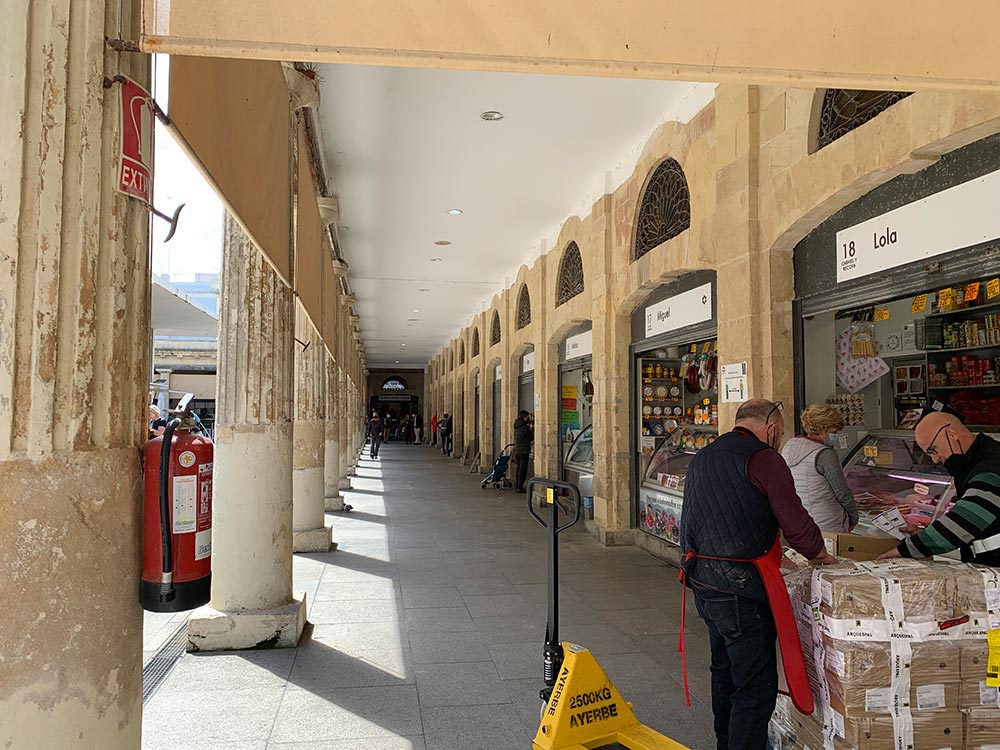

Right outside the market is the small Plaza de las Flores aka the Flower market, perfect spot to pick up some fresh flowers during the day. It is also known as Plaza Topete and is at one end of Calle Columela, one of the city’s main shopping streets.

Visiting info: The market is open from 9am to 3pm daily, while the tapas section has varying closing times in the evening – check here for more.
Torre Tavira: Camera Obscura viewpoint
Cadiz is a city of watchtowers with about 120 of them still in existence today. These towers were mostly used to communicate with the ships in harbour, especially when it came to trade, which is why most of these towers were built in the western part of Cadiz. The Torre Tavira is the highest point in old town Cadiz, rising 45m above sea level and one of the best spots for panoramic views of the city.
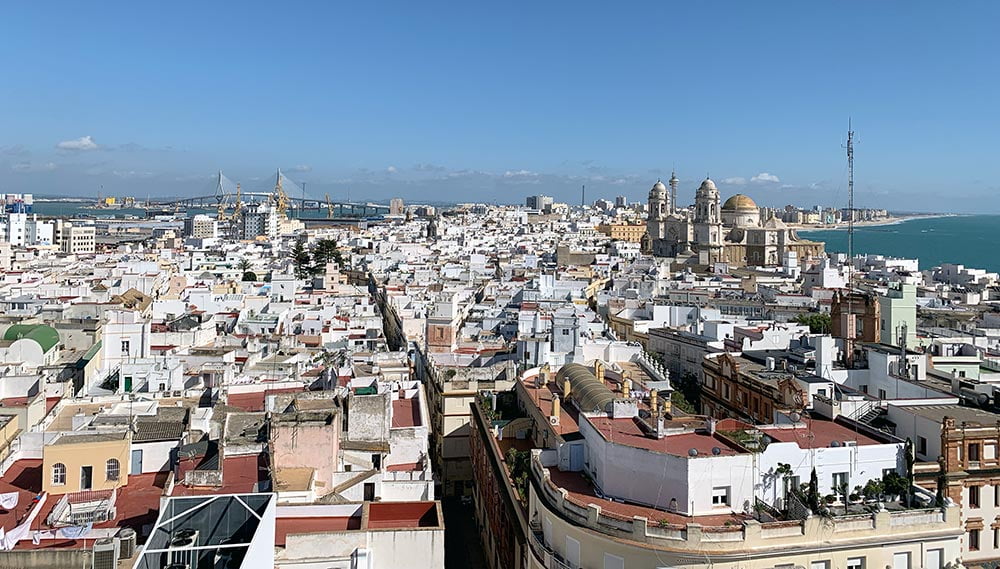
You can visit the Tavira Tower and check out the historical exhibits on site. There is also an awesome rooftop balcony with 360 views, but the highlight here is the camera obscura. This is something I actually did in Tavira, Portugal, where they use large mirrors in a periscope fashion to project live images of the surrounding area onto a large curved screen. There were tours in English and Spanish throughout the day, and my guide was pretty funny showing us the many landmarks all over the city.
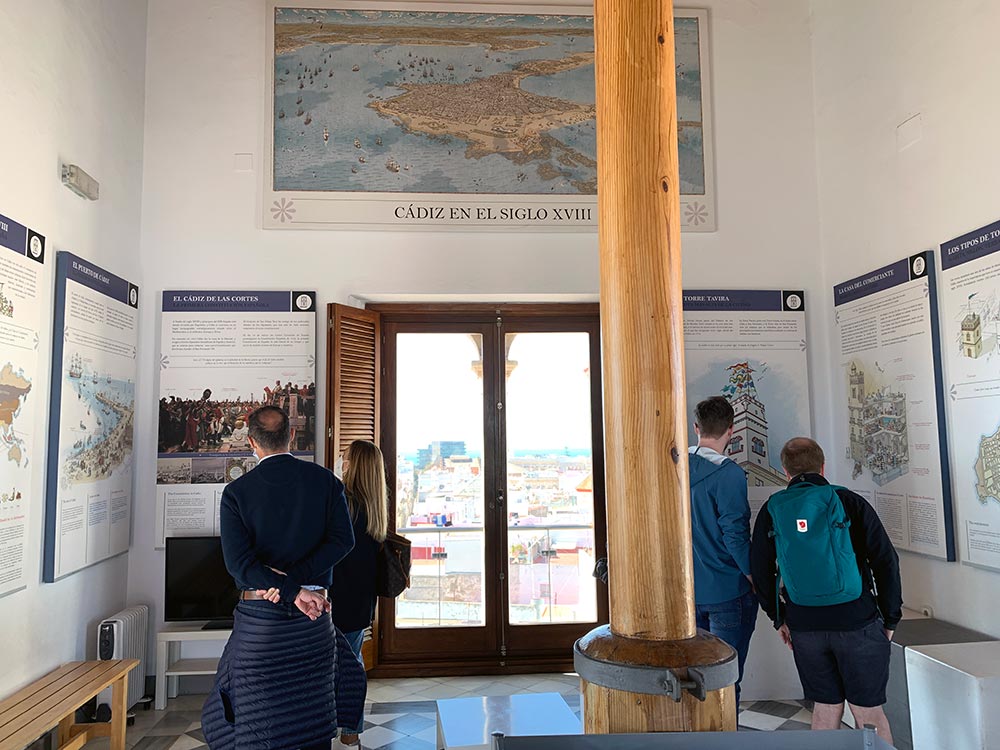
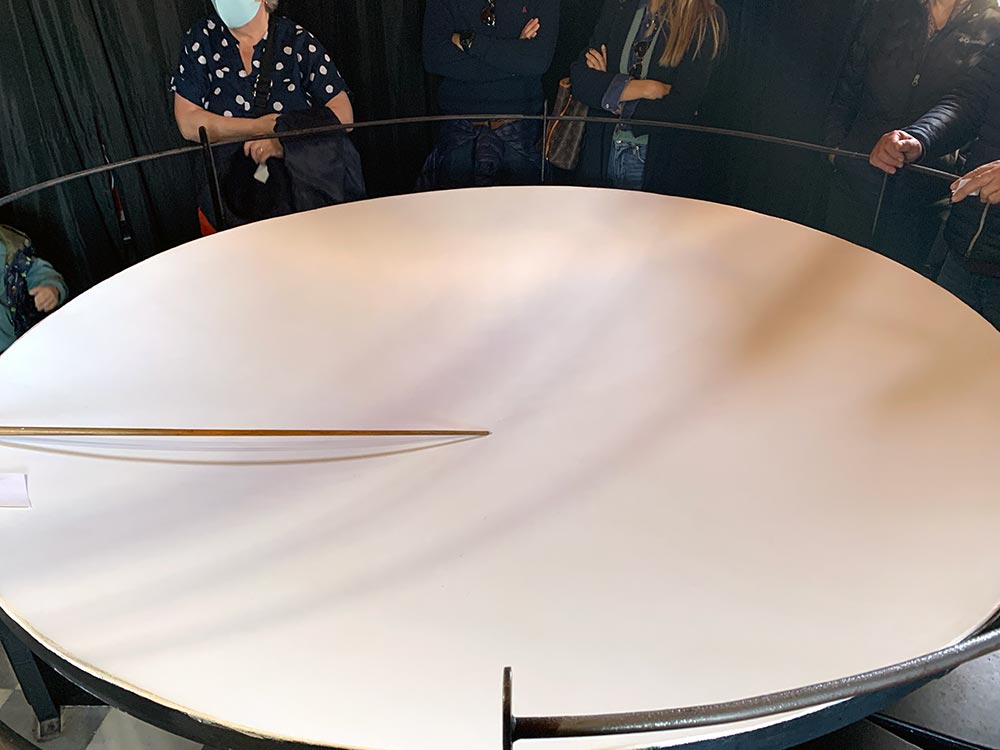
Visiting info: Tavira Tower is open 10am and closes at 6pm (Sep-Apr) or 8pm (May-Oct). A ticket costs 7 Euros. There is a fixed time to see the Camera Obscura session, but you can pop up to the roof or see the exhibits on your own time. Book your tickets online here.
If you are interested in historical artefacts, the Yacimiento Arqueological Gadir is right next to this tower
Gran Teatro Falla: Get your culture on
The mudejar influence is quite evident in the architecture of the lovely Falla Grand Theatre – something about the colour and striped arches reminds me of Cordoba’s Meqzuita. Named for a famous Andalusian composer Manuel de Falla who was born in Cadiz, the theatre is located in Plaza Frangela just off Calle Sacramento and regularly hosts performing arts programmes. There are guided tours to visi the theatre or you can see what it looks like when you buy a ticket to any of its programmes. I didn’t have time to watch anything this time round, merely walked by to enjoy its architecture.

Visiting info: Gran Teatro Falla website info and where to buy your tickets here.
Parque Genoves: Chill out spot
This botanical park on the northern end of Cadiz is the largest green space in old town Cadiz and a picturesque spot right next to the coast. There are lots of shady trees all around as well as some unusual features like La Gruta, a rock waterfall with a pond that is home to lots of ducks and swans. It’s a nice spot to rest and people watch for a bit.
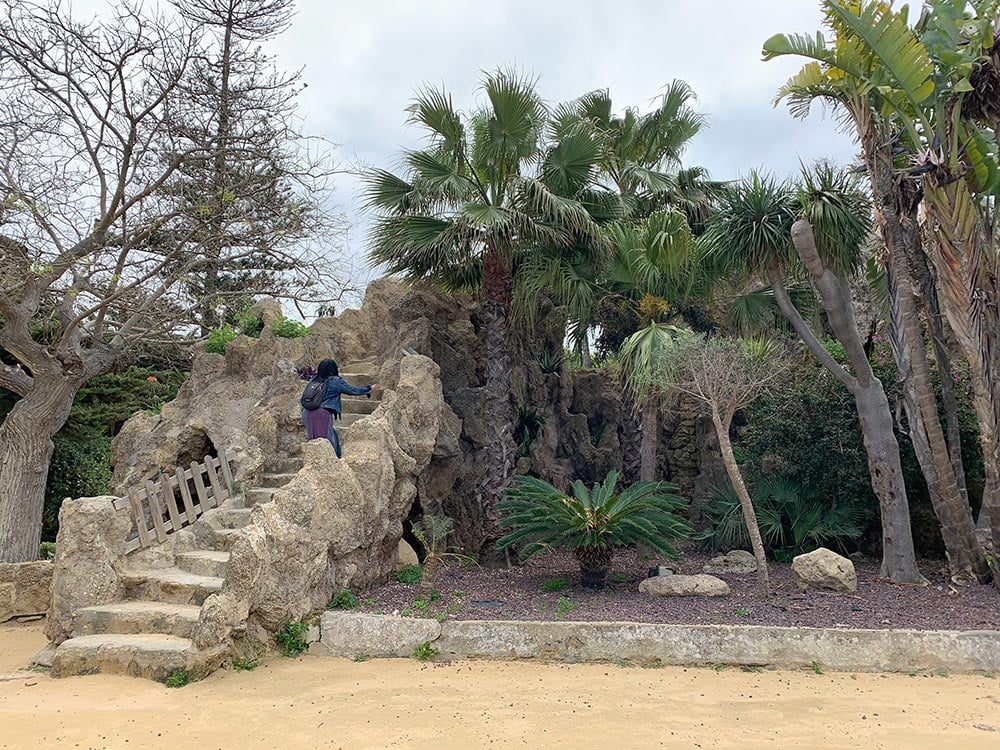
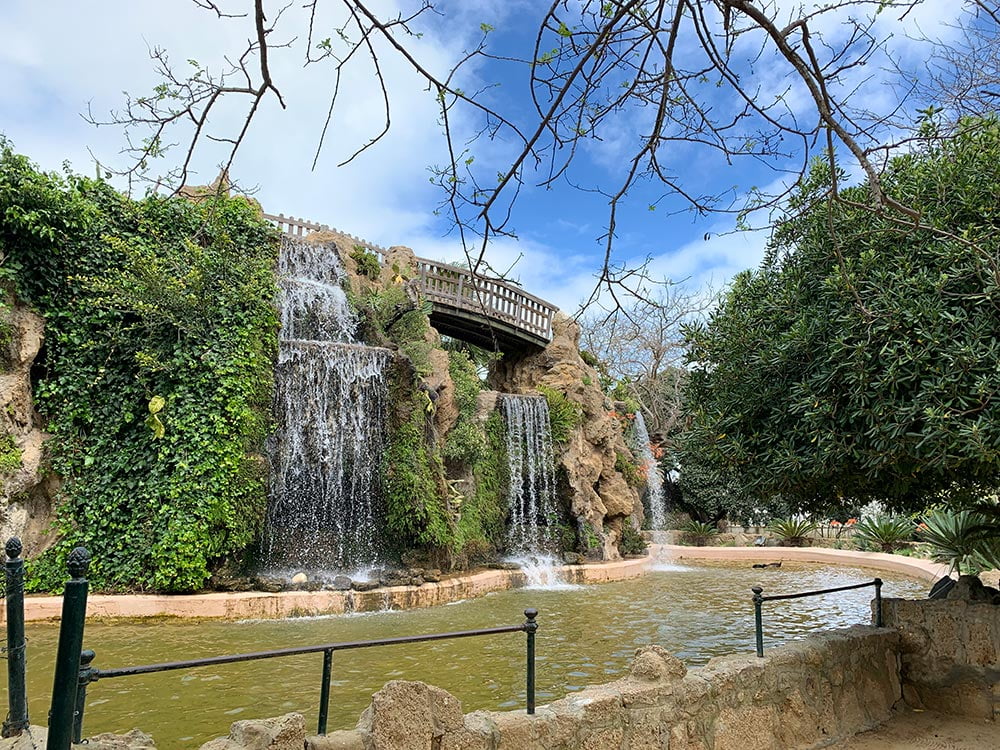
Visiting info: Opens 8am and closes at 9pm (Oct-Apr) or 11pm (May-Sep). Check out this website for more detailed information about the park.
Alameda Apodaca: Pretty coastal park
On the northern end of Cadiz is Alameda Apodaca, a small esplanade of sorts running along the coastline with a picturesque park. It’s not as crowded as the Campo del Sur, but it’s a lovely place to take a walk, with fountains and shady trees. There are 2 giant Ficus trees that can be seen here too, which apparently are over 100 years old!
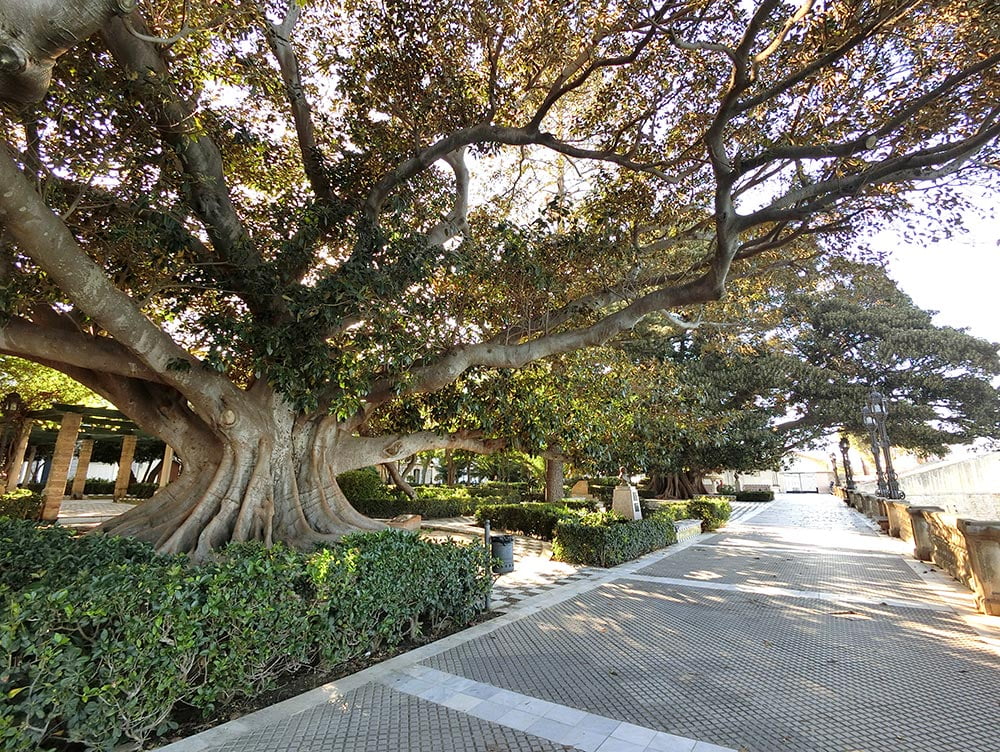
For those looking for more history, the Museo de Cadiz is supposed to be one of the top museums in the city with a mix of historical artefacts as well as contemporary artworks. One of is highlights is a pair of sarcophagi from the Phoenician times around 5th century B.C. with a pretty cool backstory and you can actually see a replica of these along the Campo del Sur near the exit of the Roman Theatre.
Also worth taking a look at is the Monumento a la Constitución de 1812 which is a grand white sculpture located in Plaza Espana close to the cruise terminal. They were doing some major refurbishment of that area when I visited Cadiz so I didn’t get a chance to look at this properly, but this monument actually commemorates the signing of the 1812 Spanish Constitution, a significant move away from the monarchy of those times.
Where to eat in Cadiz
Cadiz by the coast is of course the place to eat seafood – fish in particular is pretty good here, especially the fried fish tapas (Pescaíto frito) and fried prawn fritters (Tortillitas de camarones) When it comes to drinks, Cadiz is very close to Jerez which is a well known sherry area, so definitely try some sherry or fino while you are here. I mostly ate around the La Viña area near La Caleta Beach because that was where my guesthouse was located.
If you visit in May/June, you might also be able to catch Almadraba, a unique way of fishing bluefin tuna with fish traps that dates back to the Phoenician times.
El Faro de Cadiz
Located in La Viña, El Faro translates to lighthouse, a reference to the lighthouse at the nearby San Sebastian castle. This eatery is quite a popular local spot and apparently has turned away the Michelin award to keep prices low for its regulars. The restaurant consists of a more upmarket sit-down restaurant portion and a more casual bar/tapas side (Barra de tapeo) which is what I ended up going into.

I usually like to go to tapas bars a tad earlier than the usual Spanish eating time so I can get a seat easily, but perhaps because it was a weekday, it wasn’t too crowded when I visited. I stuck around the bar area which were mostly standing seats, but apparently there is an inner room where they serve tapas at tables.

Instead of my usual beer, I opted for a fino and ordered:
- Cazon de Adobo (Fried dogfish) – I love the burst of flavour when you bite into this fried fish
- La Tortillitas de Camarones (Shrimp fritter) – so crispy and yummy
- Gambas en Bechamel (Fried breaded prawn with white sauce) – the perfect snack food
Am happy to report that all the tapas was excellent – don’t think I can pick a favourite dish, but these are quite typical Cadiz style tapas so definitely worth trying.

El Faro de Cadiz is open for lunch (1pm – 430pm) and dinner (830pm – 1130pm) daily.
Taberna Casa Manteca
Taberna Casa Manteca is another highly recommended tapas bar that has a very traditional old school feel to it and known for very reasonably priced tapas. It’s located just off the Calle Virgen de las Palmas and just so happened that the day I visited, there was a cross being paraded around the streets so lots of onlookers and people were just waiting around for the bar to open.

The minute the place opened though, lots of people poured in but I managed to secure a spot right at the bar (solo dining for the win). I love that this bar feels like it has been around for awhile and the staff were also quite friendly overall. The owner was apparently a bullfighter back in the day, so you can spot some of those photos and memorabilia around the bar.

Along with my usual beer, here’s what I ordered:
- Chicharrones especiales – thin slices of pork that were salty, savoury and tasty! they had fried chicharrones behind the counter that wasn’t on the menu, but that looked food too
- Payoyo cheese with asparagus marmalade – this dish is something quite unique to this place and something they are quite well known for. The cheese apparently comes from goats that live in the mountains around the Cadiz province area
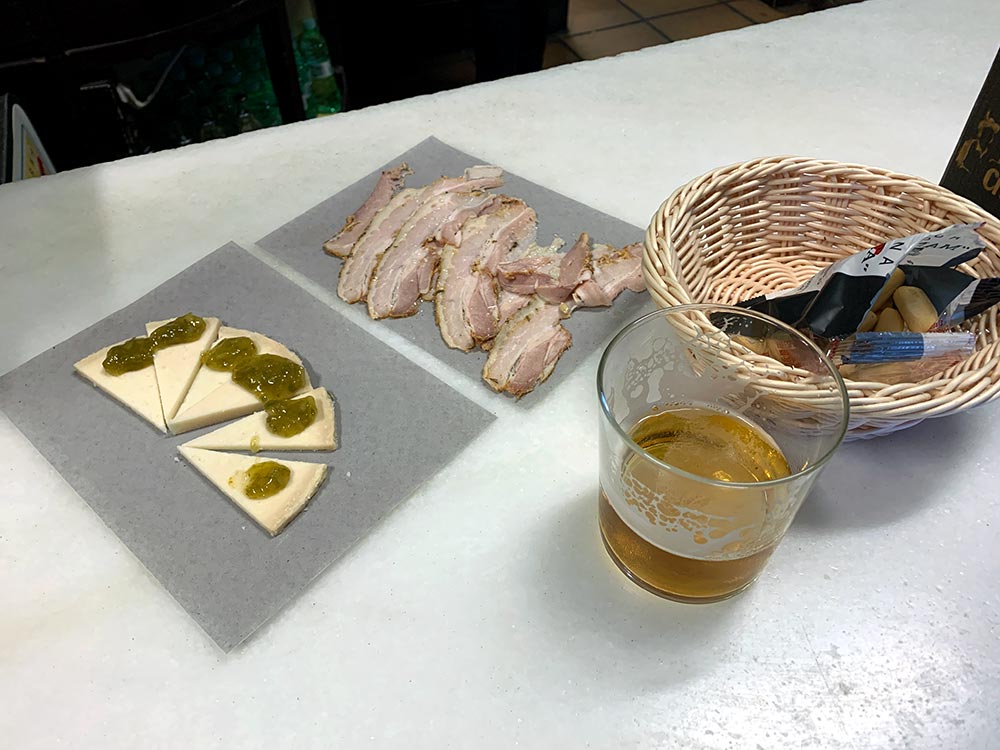
Taberna Casa Manteca is open for lunch (12pm – 4pm) and dinner (830pm – 12am) daily.
Bar La Tabernita
My walking tour passed by Bar La Tabernita located at Calle Virgen de la Palma and our guide recommended us to eat the tapas here. This bar is generally only open on Friday and the weekends so I guessed I was lucky with my timing and even managed to get an outdoor seat with a barrel table during lunch. It’s a quaint little spot.

I had a beer and two tapas dishes:
- Cazon al Coñac – dogfish marinated in cognac and tomato salsa with some fries is one of their star dishes. Pretty yummy!
- Albondigas de choco – minced cuttlefish balls in squid ink on top of some fries. Looks kinda scary, thought this was so-so compared to the cazon
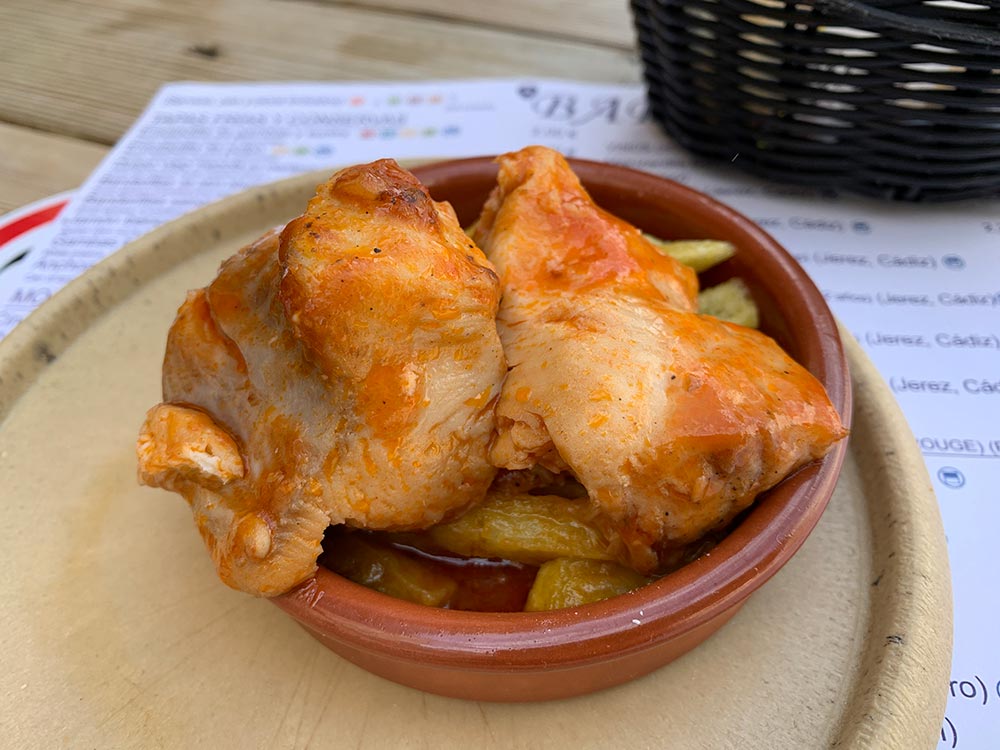
Bar la Tabernita is open Friday – Sunday for lunch (130pm – 4pm) and dinner (830pm – 11pm)
Cafe Bar El Periquito
On my first day walking around Cadiz, I was getting hungry before the typical lunch time so I wasn’t sure if there were any places where I could find food. My guesthouse recommended me to check out Cafe Bar El Periquito which is a breakfast and lunch place and they didn’t stop food service like most other places. It was pretty empty when I entered, but it seemed like a place that saw more locals than tourists, and I was just happy to get a decent tapas meal at an odd time.

For my first tapas meal in Cadiz, I knew I definitely wanted some fried fish, and the bar staff helped me pick out two different fish to fry and they were pretty yummy. I even added some calamari on after to fill up a bit more. I liked the simple chill out vibe of this eatery.
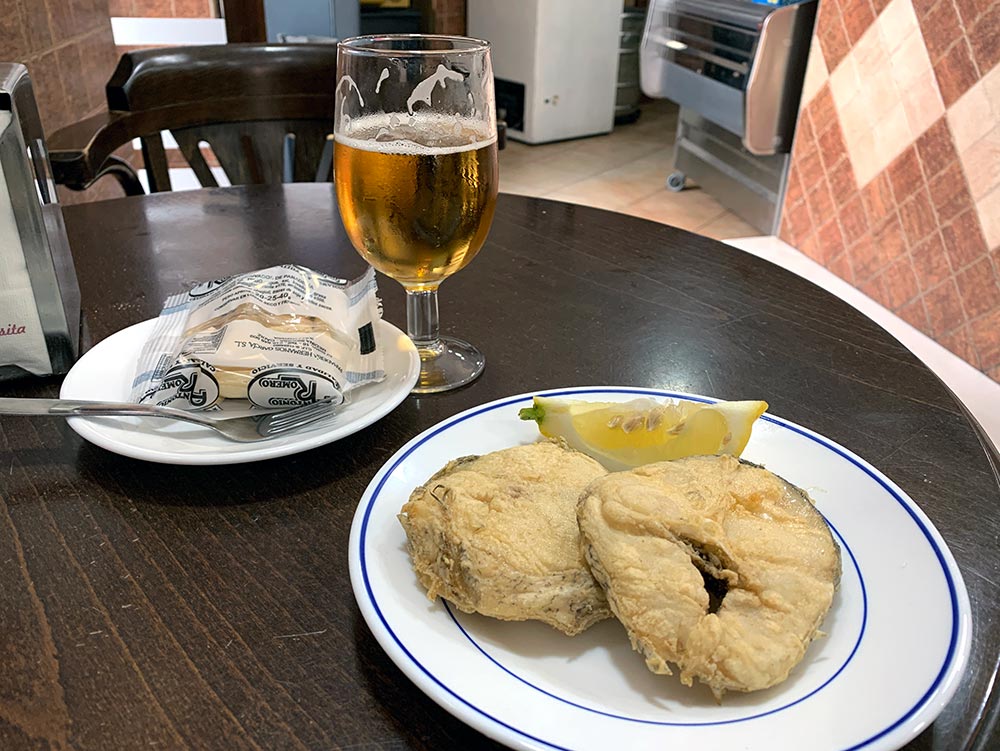
Cafe Bar El Periquito is open Sunday to Friday from 7am – 4pm (oddly closed on Saturdays)
Where to stay in Cadiz: Dormir en Cadiz
Location: I booked a room at a guesthouse (hostal, not hostel fyi) called Dormir en Cadiz [affiliate link] in the La Viña district which was a great location because I was a few minutes away from La Caleta Beach and a lot of the eating spots at Calle Virgen de la Palma. It was a 20 minute walk from the main Cadiz train station. I often found myself popping back in for an afternoon siesta before heading out again.
Room: I had a double room which had its own attached bathroom. It was a clean and cozy room – my room was up on the 3rd level so there was a bit of stair climbing every day, but the room had windows facing the street so there was nice natural light and breeze, but not noisy as this side street was never too busy.
The attached bathroom was quite small but had all the basic necessities – toilet, shower, toiletries and hairdryer as well.
I booked my room for 2 nights and paid 110 Euros (55 Euros/night) which I thought was a pretty decent price. What was also great is that they had a free cancellation at any time policy – I only paid upon arrival.

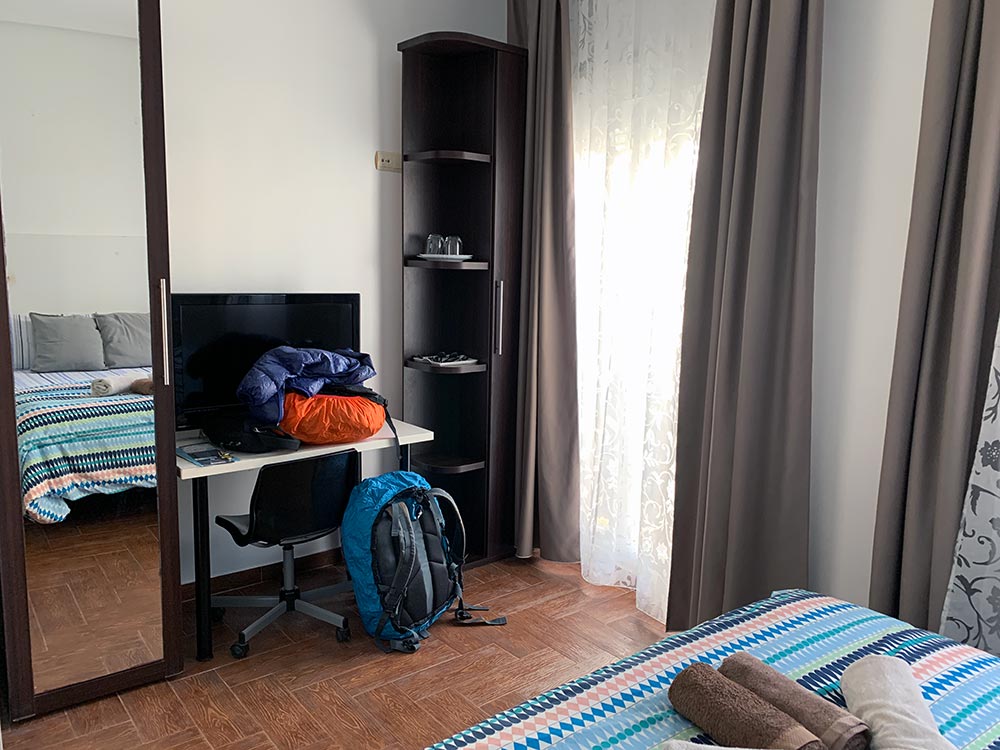

Guesthouse: The hostal was located in a traditional style building 4 storeys high and did not have any lifts. Facilities wise they don’t have a kitchen here though there is a microwave at the reception area, and they do provide free large bottled water that you can pick up at the reception as well.
The biggest thing that you makes Dormir en Cadiz awesome are the lovely staff Ana and Jaime, who were so friendly all the time and thorough with the intro to Cadiz. Ana even gave me the intro in slow Spanish so I could practice listening and talking, but she also spoke very good English as well. I would 100% come back here again on service alone.
More info about Hostal Dormir en Cadiz on booking.com [affiliate link]
Other Cadiz accommodation options that I was considering [booking.com affiliate links]
- Plaza de la Luz Cadiz: Nice looking apartment on the street right next to Calle Virgen de la Palma
- Planeta Cadiz Hostel: Budget option for those who don’t mind dormitories but they also have private rooms, overall looks like ap retty nice hostel!
- Casa Caracol: Small hostel with modern design and reviews reflect quite a communal vibe, no private bathrooms though
Did I miss anything cool in Cadiz? Let me know in the comments! And if you are planning a trip to Spain, check out my latest posts here:

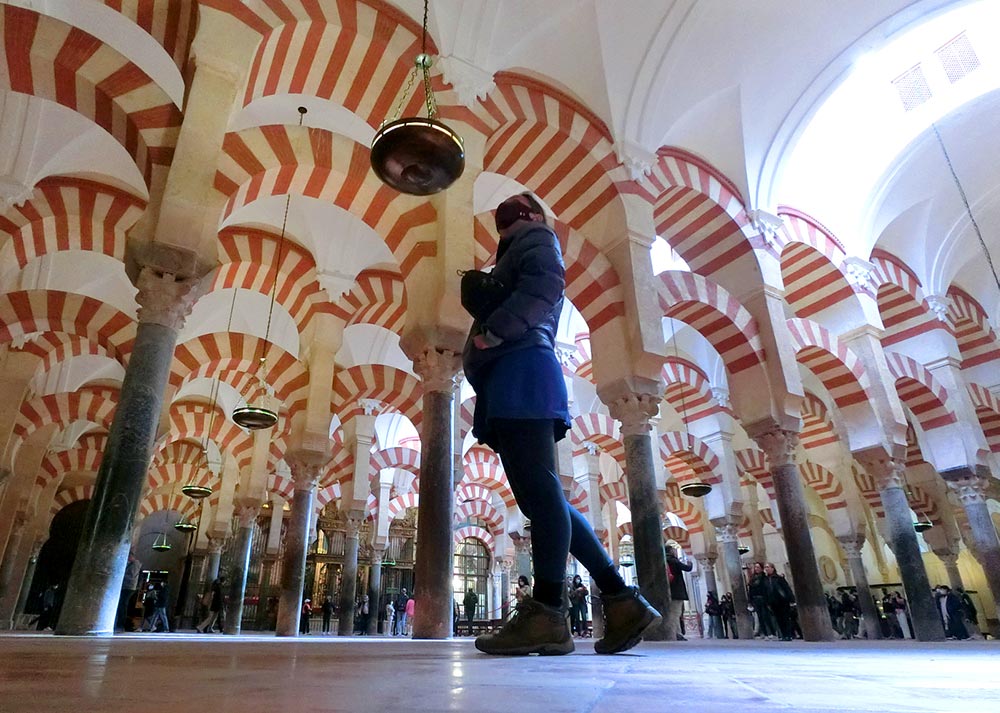
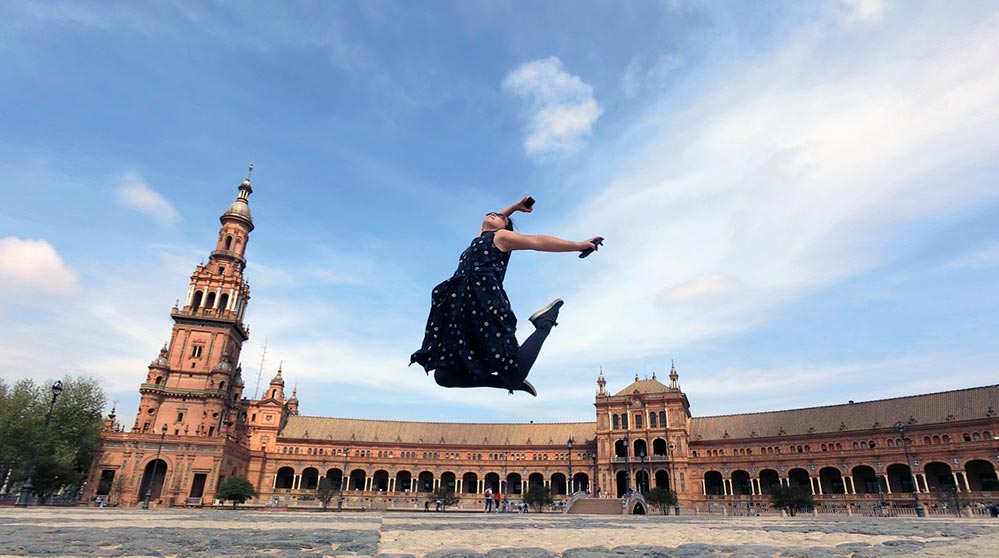

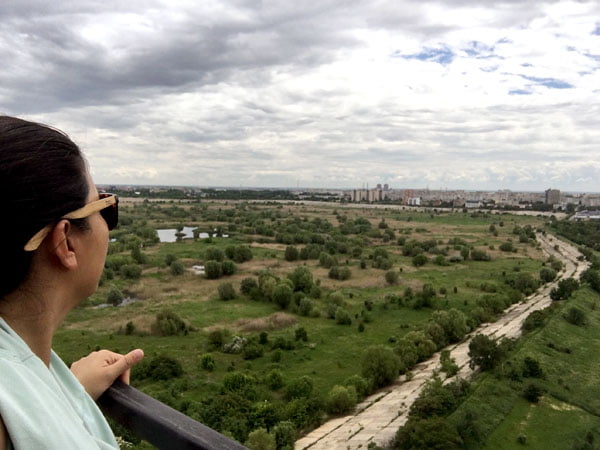

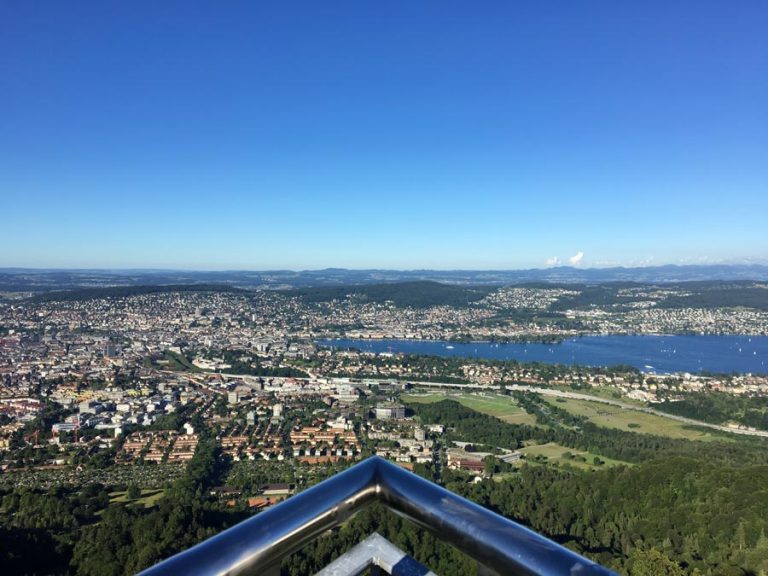
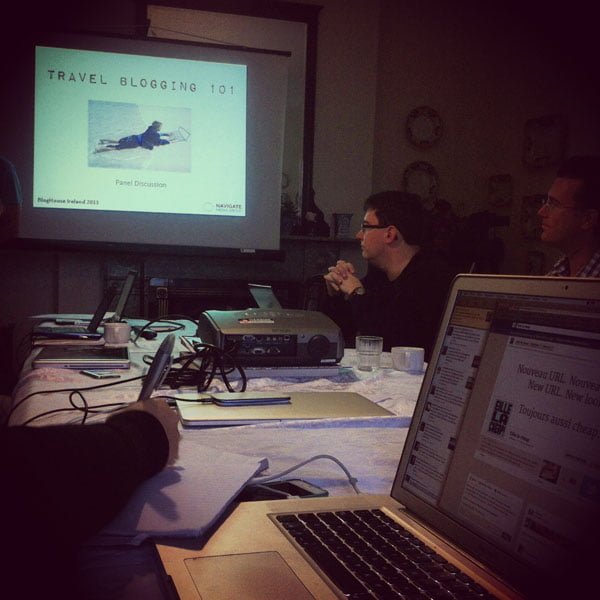
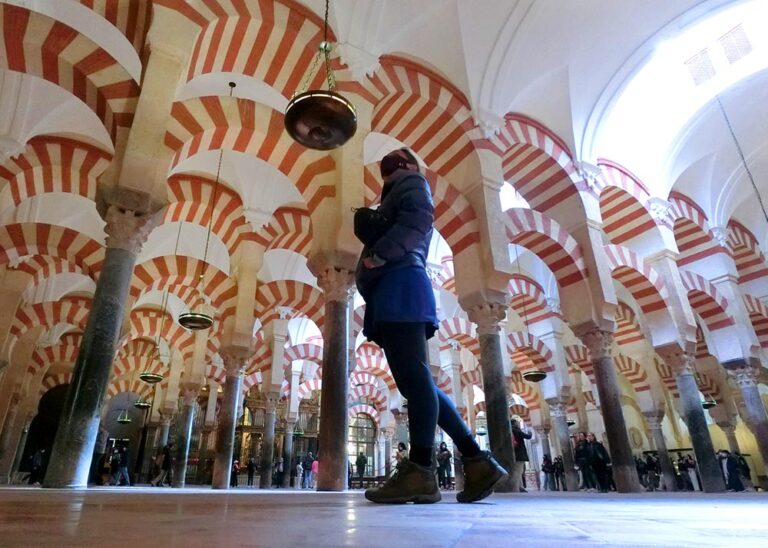
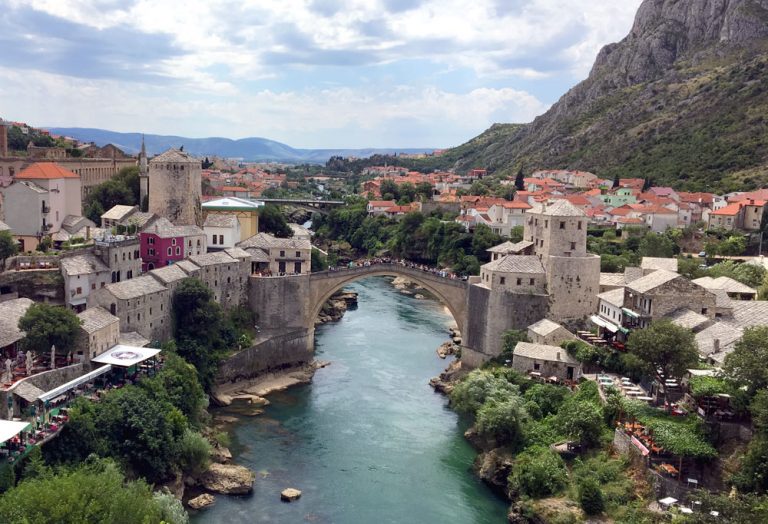
Hey!
I don’t normally leave comments on blogs but your post about Cadiz helped my solo travel alot! Super well structured too, thanks so much :-). Glad I didn’t skip another blog.
Cheers,
Jasmine
Thank you and glad you had a good solo trip!